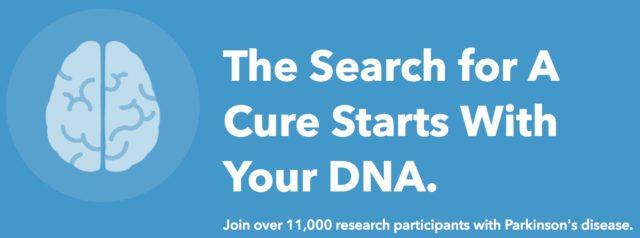Last year marked the tenth anniversary of 23andMe’s Parkinson’s Disease Research Community. 
This community has not only helped our scientists and others make serious advances in the study of Parkinson’s but it has also ushered in a new approach to genetic research.
As part of Parkinson’s Awareness Month, we wanted to look back over the now 11 years since we formed the Parkinson’s Research Community and note some of what we’ve accomplished.
Growing Quickly
Back in 2009, when 23andMe first announced its plan to enroll 10,000 people with Parkinson’s disease, 23andMe didn’t even have 10,000 customers. With the help from our collaboration with The Michael J. Fox Foundation (MJFF) and the Parkinson’s Institute, however, the company met its goal within five years. That milestone was just the first of many, as the community has helped power relevant research and insights into the disease.
Having so many people living with Parkinson’s participating in our research has meant that 23andMe’s genetic data repository on Parkinson’s is materially larger than anything that came before. Now it is by far the world’s largest cohort of its kind for Parkinson’s disease research. Now is a great time to reflect on some of our important discoveries and to remember that none of it would have been possible without the active participation of the 23andMe research participants and the dedication of scientists within and outside of 23andMe.
Some Milestones
Here are a few highlights:
- To date, our researchers and collaborators discovered 90 genetic variants associated with the disease. These findings give scientists potential pathways for future research and insight into possible new drug targets to treat Parkinson’s.
- 23andMe researchers and collaborators have published 18 papers in peer-reviewed publications, including four in 2020 alone. Among those papers are new findings around putative causal risk factors for Parkinson’s, genetic variants that influence the age of onset for Parkinson’s, and a genome-wide association study that was paired with single-cell gene expression data to help identify cell types that are important for understanding the causes of Parkinson’s.
- 23andMe researchers have identified more than 100 phenotypic — or non-genetic traits or characteristics — associations with Parkinson’s, offering the potential of earlier detection of the disease.
- 23andMe researchers, in collaboration with scientists from The Michael J. Fox Foundation, are also pioneering novel ways of collecting and analyzing data to gain deeper insight into the disease. Among these new datasets is one, collected by 23andMe researchers, looking at off-label drug use among Parkinson’s patients. This is a practice by which doctors use medication approved by the FDA for one condition to treat other conditions for which the medication is not yet approved.
- The Michael J. Fox Foundation launched Fox Insight, an online clinical study to crowdsource data from people with and without Parkinson’s. Through a collaboration with 23andMe, eligible participants can also access the 23andMe Health + Ancestry Service and add their genetic information to the study at no cost. To date, more than 40,000 people are registered in the study — with the goal of recruiting hundreds of thousands more. And more recently, MJFF launched Fox DEN, Fox Insight’s online portal to provide qualified Parkinson’s researchers access to its de-identified data.
- We’ve also recently completed a small-scale pilot study looking at the gut and oral microbiomes of people with Parkinson’s. We plan to follow this up with a much larger study later this year including healthy controls.
- In the past year, 23andMe’s Parkinson’s Disease Research strategy has expanded to include participants who are at increased risk of developing Parkinson’s disease. By participating in this research, people without Parkinson’s disease can help researchers better understand the factors that influence why some people develop Parkinson’s disease. This could help contribute to the development of new interventions and treatments to prevent or slow the progression of the disease. This expansion of research was kicked off with the launch of the Parkinson’s Impact Project, which focuses on individuals that carry the LRRK2 G2019S variant. 23andMe plans to expand research efforts to other at-risk cohorts in the near future.
- As part of the Parkinson’s Impact Project, we kicked off enrollment of LRRK2 G2019S carriers, both with and without Parkinson’s disease, into the University of Rochester’s innovative telemedicine study, VALOR-PD.
A Model for 23andMe Research
23andMe’s Parkinson’s Research Community is unique in that it allows for ongoing engagement with participants. In addition, we see that customers are also eager to take an active role. Because these individuals are so engaged, scientists are better able to track changes and understand the progression of Parkinson’s, as well as nimbly add new dimensions to their research. It may even help in identifying potential participants in clinical studies and accelerate the pace of drug development.
Beyond the participants in the community, 23andMe’s Parkinson’s disease research is more potent because of the millions of 23andMe customers who, while not part of the community, opt-in to participate in 23andMe Research. Having such a large number of “controls” is vital for researchers.
By leveraging online tools, computational know-how, engaged customers, and massive amounts of both phenotypic and genetic data, 23andMe has pioneered a new way of conducting genetic research over the past ten years. 23andMe’s ambitious efforts around Parkinson’s disease, also helped the company create the framework for how it, and now others, approach genetic research into other conditions.
There is no other study cohort with the scale and diversity of 23andMe, which has millions of participants who are both engaged and interested in contributing to research.




